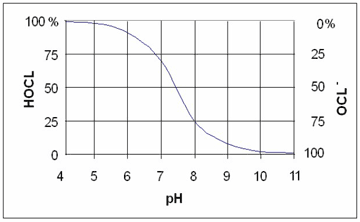Understanding the difference between free and combined chlorine is crucial to understanding water quality after chlorination. Testing the water for both free and combined chlorine allows you to know whether the water you've chlorinated is of sufficient quality to drink or disinfect your process, depending upon your application.
So, what's the difference?
Pure chlorine exists as a molecule as a gas (Cl2 ) and when dissolved in water it will react with water to form mostly hypochlorous acid (HOCl):
Cl2 + H2O ↔ HCl + HOCl
Depending on the pH of the water (see image below), the hypochlorous acid (HOCl) will partially dissociate to the hypochlorite ion (OCl-). Both hypochlorous acid and hypochlorite disinfect water but hypochlorous is acid is a more effective disinfectant.

By definition, free chlorine refers to all chlorine present in the water as Cl2(g), HOCl(aq) and OCl-(aq).
Portable water testing methods such as DPD do not distinguish between these three species, and they are all termed free chlorine, with the capability to disinfect microorganisms in the same way as Cl2. Free chlorine will often be denoted as Cl2 in water treatment applications and literature, but can refer to any of the three forms.
When free chlorine is initially added to water it can undergo a very quick reaction with other contaminants in the water, mostly ammonia, NH3. This will result in the formation of chloramines, and the 'free' chlorine is converted to 'combined' chlorine:
NH3 → NH2Cl → NHCl2 → NCl3
That is; ammonia → monochloramine → dichloramine → nitrogen trichloride (trichloramine)